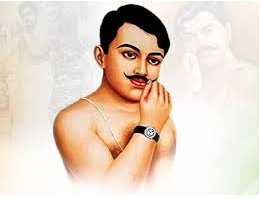Syllabus:
GS1: The Freedom Struggle – its various stages and important contributors /contributions from different parts of the country.
Context:
Recently, the Prime Minister has paid tributes to Chandra Shekhar Azad on his birth anniversary.
More on the News
- The 119th birth anniversary of the revolutionary freedom fighter Chandrashekhar Azad was celebrated on July 23rd, 2025.
About Chandra Shekhar Azad
Early Life:

- He was born in the princely state of Alirajpur (present-day Madhya Pradesh) in 1906.
- Chandra Shekhar Sitaram Tiwari moved to Benares, where a Sanskrit school offered free lodging but he was uninterested in studies.
- With the Non-Cooperation Movement at its peak, the city’s political energy drew him toward activism.
- He was a part of Congress-organised youth groups, picketing liquor shops and participating in protests.
- He would eventually be arrested, charged with disrupting public disorder and produced before a magistrate.
- After his release, Chandra Shekhar dropped his Brahmin surname and adopted the title ‘Azad’, vowing never to be captured alive again.
Contribution to the Freedom Movement:
- Azad was very upset when Gandhi called off the Non-Cooperation Movement in February 1922.
- Hindustan Republican Association: He would soon join the Hindustan Republican Association of Ram Prasad Bismil and Sachindranath Sanyal in 1924, where he participated in numerous political dacoities to raise funds for an eventual armed uprising.
Kakori train robbery of 1925:
- The Kakori train incident, also called the Kakori Conspiracy, took place on August 9, 1925, near Lucknow.
- It was carried out by members of the Hindustan Republican Association (HRA) to fund their fight against British rule.
- The revolutionaries stopped a train and looted government treasury funds being transported on board.
Hindustan Socialist Republican Association (HSRA):
- In 1928, the Hindustan Republican Army was renamed the Hindustan Socialist Republican Association (HSRA) to reflect a shift towards socialist ideals and mass politics, inspired by the Russian Revolution.
- The HSRA aimed to overthrow imperialist rule in India through armed struggle and establish a socialist republic based on universal suffrage and the abolition of exploitation.
- Bhagat Singh guided the organisation with his political ideas while Azad led its military actions.
Saunders Murder
- He is best known for planning and carrying out the killing of British police officer John Saunders in Lahore in December 1928, to avenge the death of Lala Lajpat Rai.
- Bhagat Singh and Rajguru shot Saunders, while Azad killed a police constable who tried to chase them.
Last stand in Allahabad:
- On February 27, 1931, Azad was ambushed by police at Alfred Park, Allahabad, while heading to meet Sukhdev Raj. Though outnumbered and outgunned, he fought back bravely.
- He helped Sukhdev escape and put up his final stand. He shot as many as three policemen dead, but was badly injured in the process.
- With only one bullet left in his pistol, Azad decided to stay true to his resolve to never be taken alive and shot himself in the head.
- The Park was renamed Chandra Shekhar Azad Park in honor of the revolutionary freedom fighter Chandra Shekhar Azad.

